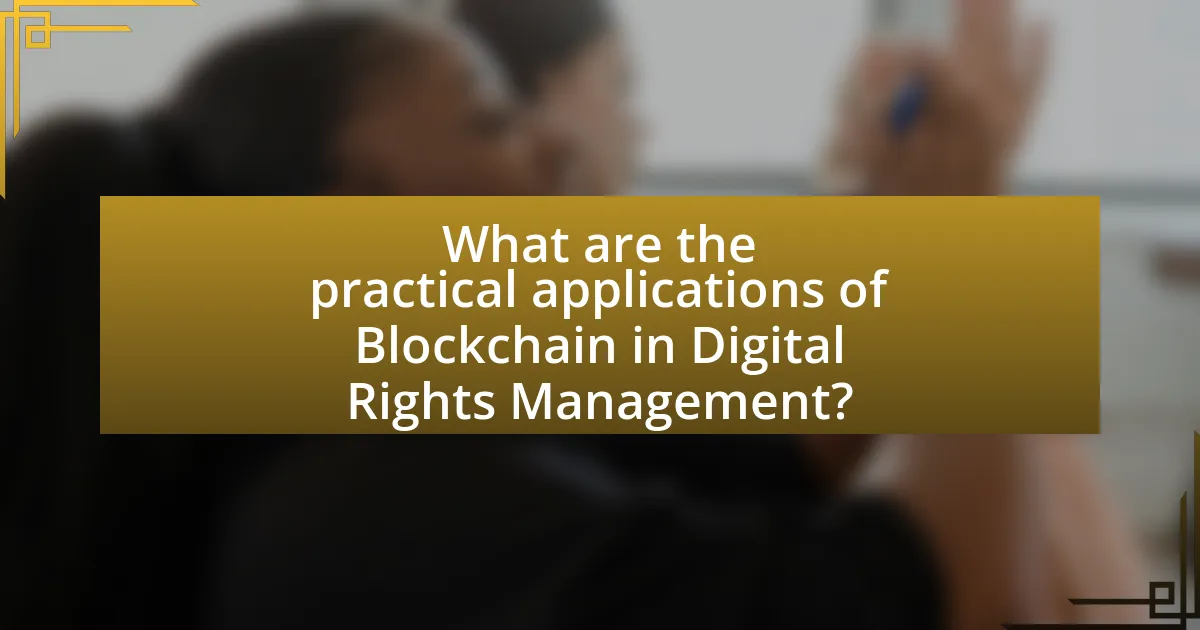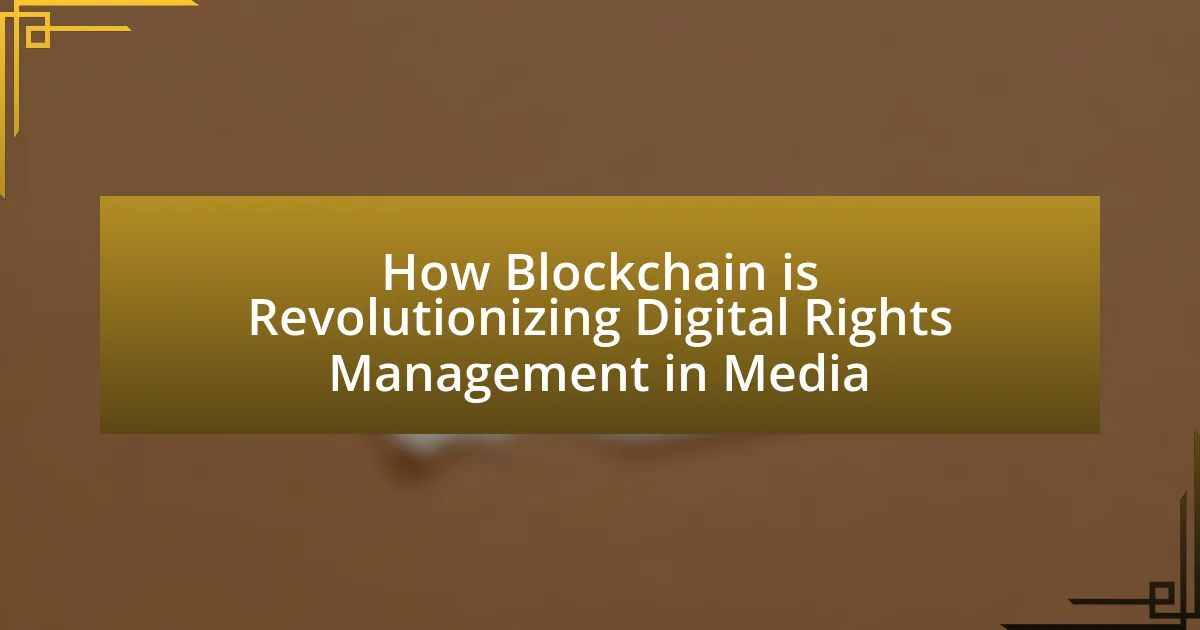Blockchain technology is revolutionizing Digital Rights Management (DRM) in the media sector by offering a decentralized and transparent framework for tracking ownership and usage rights. This article explores how blockchain enables creators to register their works securely, facilitates direct transactions, and automates licensing through smart contracts, thereby addressing challenges such as piracy, user inconvenience, and interoperability issues inherent in traditional DRM systems. It also examines the practical applications of blockchain in media, the impact on revenue models, and the future implications for content creators and consumers, highlighting the need for robust strategies and compliance with legal standards in the evolving landscape of digital rights management.

How is Blockchain Transforming Digital Rights Management in Media?
Blockchain is transforming digital rights management (DRM) in media by providing a decentralized and transparent system for tracking ownership and usage rights. This technology enables creators to register their works on a blockchain, ensuring immutable proof of ownership and facilitating direct transactions between creators and consumers. For instance, platforms like Audius and Ujo Music utilize blockchain to allow artists to control their content distribution and receive fair compensation without intermediaries. Additionally, smart contracts automate licensing agreements, reducing administrative costs and disputes. The integration of blockchain in DRM is evidenced by the increasing adoption of these platforms, which collectively demonstrate a shift towards more equitable and efficient management of digital rights in the media industry.
What are the key challenges in traditional Digital Rights Management?
The key challenges in traditional Digital Rights Management (DRM) include piracy, user inconvenience, and interoperability issues. Piracy remains a significant threat, as traditional DRM systems often fail to prevent unauthorized copying and distribution of digital content, leading to substantial revenue losses for creators and distributors. User inconvenience arises from restrictive access controls that can frustrate legitimate consumers, resulting in a negative user experience and potential loss of sales. Additionally, interoperability issues occur when DRM systems are not compatible across different platforms and devices, limiting the accessibility of content and hindering its distribution. These challenges highlight the limitations of traditional DRM approaches in effectively protecting digital content while ensuring a seamless user experience.
How do these challenges affect content creators and consumers?
Challenges in digital rights management significantly impact content creators and consumers by creating barriers to fair compensation and access. Content creators often face difficulties in monetizing their work due to piracy and lack of transparency in revenue distribution, leading to reduced income and motivation to produce quality content. For instance, a study by the International Intellectual Property Alliance reported that U.S. copyright industries lost over $200 billion annually due to piracy. Consumers, on the other hand, may experience limited access to content or inflated prices as creators seek to recover losses from piracy, resulting in a less diverse media landscape. Thus, these challenges create a cycle that undermines both the financial viability for creators and the accessibility for consumers.
What limitations exist in current DRM technologies?
Current DRM technologies face several limitations, including vulnerability to circumvention, high costs of implementation, and lack of interoperability across platforms. These technologies often rely on encryption methods that can be bypassed by determined users, undermining their effectiveness in protecting digital content. Additionally, the implementation of DRM systems can be expensive for content creators and distributors, which may deter smaller entities from utilizing them. Furthermore, many DRM solutions are not compatible with various devices and platforms, leading to a fragmented user experience and limiting access to content. These limitations highlight the need for more robust and flexible solutions, such as those offered by blockchain technology, which can address these challenges more effectively.
Why is Blockchain considered a solution for these challenges?
Blockchain is considered a solution for challenges in digital rights management in media due to its ability to provide transparent, immutable records of ownership and transactions. This technology enables creators to securely register their intellectual property, ensuring that rights are clearly defined and easily traceable. For instance, a study by the World Economic Forum highlights that blockchain can reduce piracy and unauthorized use of content by allowing artists to track their work and receive fair compensation through smart contracts. These contracts automatically execute payments when content is accessed, thereby enhancing revenue streams for creators and reducing disputes over rights.
What unique features of Blockchain enhance Digital Rights Management?
Blockchain enhances Digital Rights Management (DRM) through its unique features of decentralization, immutability, and transparency. Decentralization allows for a distributed ledger that eliminates the need for a central authority, enabling creators to maintain control over their intellectual property. Immutability ensures that once rights and ownership information is recorded on the blockchain, it cannot be altered or deleted, providing a permanent record of ownership. Transparency allows all stakeholders to verify rights and transactions in real-time, reducing disputes and enhancing trust among creators, distributors, and consumers. These features collectively empower creators by providing them with secure, verifiable, and efficient management of their digital rights.
How does Blockchain ensure transparency and security in media rights?
Blockchain ensures transparency and security in media rights by providing a decentralized ledger that records all transactions related to media assets. This technology allows for immutable records, meaning once data is entered, it cannot be altered or deleted, which enhances trust among stakeholders. Each transaction is time-stamped and linked to a unique cryptographic hash, ensuring that ownership and rights can be verified without the need for intermediaries. For instance, platforms like Myco and Ujo Music utilize blockchain to track ownership and distribution rights, allowing creators to receive fair compensation directly. This transparency reduces disputes over rights and ensures that all parties have access to the same information, thereby fostering a more equitable media ecosystem.

What are the practical applications of Blockchain in Digital Rights Management?
Blockchain technology has practical applications in Digital Rights Management (DRM) by providing secure, transparent, and immutable records of ownership and usage rights for digital content. This technology enables creators to register their works on a blockchain, ensuring that their intellectual property is protected and easily verifiable. For instance, platforms like Myco and Ujo Music utilize blockchain to allow artists to manage their rights and royalties directly, eliminating intermediaries and ensuring that payments are made transparently and promptly. Additionally, blockchain can facilitate the tracking of content usage across various platforms, ensuring that rights holders receive appropriate compensation for their work. This application of blockchain not only enhances the security of digital assets but also fosters trust among creators, distributors, and consumers in the media industry.
How are media companies currently implementing Blockchain for DRM?
Media companies are currently implementing blockchain for Digital Rights Management (DRM) by utilizing decentralized ledgers to secure and track ownership of digital content. This technology allows for transparent and immutable records of transactions, enabling creators to maintain control over their intellectual property. For instance, companies like Audius and Ujo Music leverage blockchain to facilitate direct payments to artists, ensuring they receive fair compensation without intermediaries. Additionally, platforms such as VeChain are being used to authenticate and verify the provenance of digital assets, thereby reducing piracy and unauthorized distribution. These implementations demonstrate how blockchain enhances the efficiency and security of DRM processes in the media industry.
What case studies illustrate successful Blockchain integration in media?
Successful blockchain integration in media is illustrated by case studies such as the partnership between the music platform Audius and blockchain technology, which allows artists to publish their music directly to fans while retaining control over their rights and revenue. Another example is the use of blockchain by the film industry, specifically the project “The Abyss,” which utilized blockchain for transparent revenue sharing among creators and investors. Additionally, the platform VeChain has been employed in the luxury goods sector to authenticate and track media-related merchandise, ensuring that intellectual property rights are upheld. These case studies demonstrate how blockchain enhances transparency, control, and efficiency in digital rights management within the media industry.
How do these implementations impact revenue models for media companies?
Implementations of blockchain technology significantly enhance revenue models for media companies by enabling more efficient digital rights management and reducing piracy. By utilizing smart contracts, media companies can automate royalty payments, ensuring that creators receive fair compensation in real-time, which can lead to increased trust and collaboration within the industry. According to a report by Deloitte, blockchain can reduce transaction costs by up to 30%, allowing media companies to allocate resources more effectively and potentially increase profit margins. Furthermore, the transparency and traceability of blockchain can help in accurately tracking content usage, thereby optimizing advertising revenues and subscription models.
What role do smart contracts play in Blockchain-based DRM?
Smart contracts play a crucial role in Blockchain-based Digital Rights Management (DRM) by automating the enforcement of rights and agreements related to digital content. These self-executing contracts facilitate transparent and tamper-proof transactions, ensuring that creators receive fair compensation for their work through predefined conditions. For instance, when a user purchases or streams content, the smart contract automatically distributes payments to the rights holders based on the agreed terms, eliminating intermediaries and reducing transaction costs. This automation enhances efficiency and trust in the distribution process, as all parties can verify the terms and transactions on the blockchain, which is immutable and publicly accessible.
How do smart contracts automate rights management processes?
Smart contracts automate rights management processes by executing predefined agreements automatically when specific conditions are met. This automation reduces the need for intermediaries, streamlining transactions related to licensing, royalties, and usage rights. For instance, when a digital asset is used, a smart contract can automatically distribute payments to rights holders based on the terms encoded within it, ensuring timely and accurate compensation. This efficiency is supported by blockchain technology, which provides a transparent and immutable record of all transactions, enhancing trust among parties involved in rights management.
What are the benefits of using smart contracts for content distribution?
Smart contracts provide several benefits for content distribution, including automation, transparency, and security. Automation allows for self-executing agreements that eliminate the need for intermediaries, reducing costs and speeding up transactions. Transparency ensures that all parties have access to the same information regarding rights and payments, fostering trust among creators and distributors. Security is enhanced through blockchain technology, which protects against unauthorized access and fraud by providing an immutable record of transactions. These features collectively streamline the content distribution process, making it more efficient and reliable.

What are the future implications of Blockchain in Digital Rights Management?
The future implications of Blockchain in Digital Rights Management (DRM) include enhanced transparency, improved security, and streamlined royalty distribution. Blockchain technology enables immutable records of ownership and usage rights, allowing creators to maintain control over their intellectual property. This decentralized approach reduces the risk of piracy and unauthorized use, as every transaction is recorded on a public ledger. Furthermore, smart contracts can automate royalty payments, ensuring that artists receive fair compensation in real-time, which addresses long-standing issues of delayed payments in traditional DRM systems. Studies indicate that implementing blockchain in DRM could reduce administrative costs by up to 30%, making it a financially viable solution for content creators and distributors alike.
How might Blockchain evolve in the context of media rights?
Blockchain may evolve in the context of media rights by enabling more transparent and efficient management of intellectual property. This evolution can be seen through the implementation of smart contracts, which automate licensing agreements and ensure that creators receive fair compensation in real-time. For instance, platforms like Audius utilize blockchain to allow artists to directly monetize their work without intermediaries, thereby increasing revenue share for creators. Additionally, the immutable nature of blockchain records can help in tracking ownership and usage rights, reducing piracy and unauthorized distribution. As a result, the integration of blockchain technology in media rights management could lead to a more equitable ecosystem for content creators and consumers alike.
What emerging trends should stakeholders be aware of?
Stakeholders should be aware of the trend of decentralized digital rights management (DRM) systems enabled by blockchain technology. This trend allows for transparent and secure tracking of ownership and usage rights, reducing piracy and unauthorized distribution. According to a report by Deloitte, blockchain can streamline royalty payments and ensure that creators receive fair compensation, as it provides an immutable ledger of transactions. Additionally, the rise of non-fungible tokens (NFTs) is transforming how digital assets are bought, sold, and owned, further emphasizing the importance of blockchain in DRM.
How can media professionals prepare for a Blockchain-driven future?
Media professionals can prepare for a Blockchain-driven future by acquiring knowledge of blockchain technology and its applications in digital rights management. Understanding how blockchain can enhance transparency, security, and efficiency in content distribution will be crucial, as it allows for immutable records of ownership and transactions. For instance, a study by the World Economic Forum highlights that blockchain can reduce piracy and ensure fair compensation for creators by providing a decentralized platform for tracking rights and royalties. Additionally, professionals should engage with blockchain communities and participate in relevant training programs to stay updated on industry developments and best practices.
What best practices should be followed when adopting Blockchain for DRM?
When adopting Blockchain for Digital Rights Management (DRM), organizations should prioritize transparency, interoperability, and user privacy. Transparency ensures that all transactions and rights management activities are recorded on a public ledger, allowing stakeholders to verify ownership and usage rights easily. Interoperability is crucial for enabling different blockchain systems to communicate, which facilitates broader adoption and integration across platforms. User privacy must be maintained by implementing robust encryption methods to protect sensitive information while still allowing for rights verification.
These best practices are supported by the growing trend of blockchain adoption in various industries, where transparency has been shown to reduce disputes over ownership and usage rights, as evidenced by projects like Myco and Ujo Music, which utilize blockchain to manage digital content rights effectively.
How can organizations ensure compliance with legal standards in Blockchain usage?
Organizations can ensure compliance with legal standards in blockchain usage by implementing robust governance frameworks that align with existing regulations. This involves conducting thorough legal assessments to identify applicable laws, such as data protection regulations and intellectual property rights, and integrating these requirements into blockchain protocols. For instance, the General Data Protection Regulation (GDPR) mandates that organizations must ensure data privacy, which can be achieved by incorporating features like data encryption and user consent mechanisms within blockchain systems. Additionally, organizations should engage legal experts to continuously monitor regulatory changes and adapt their blockchain applications accordingly, ensuring ongoing compliance and minimizing legal risks.
What strategies can enhance the effectiveness of Blockchain in DRM?
Implementing smart contracts is a key strategy to enhance the effectiveness of Blockchain in Digital Rights Management (DRM). Smart contracts automate the execution of agreements, ensuring that rights holders receive payments instantly upon usage of their content, thereby reducing transaction costs and delays. Additionally, utilizing decentralized storage solutions can improve data integrity and security, as content is stored across multiple nodes, making it less vulnerable to tampering or loss. Furthermore, integrating identity verification mechanisms can ensure that only authorized users access and utilize the content, thus protecting the rights of creators. These strategies collectively contribute to a more efficient, secure, and transparent DRM system, aligning with the fundamental principles of Blockchain technology.

Leave a Reply